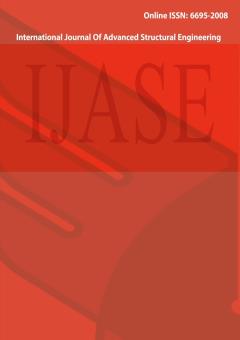A Comparison of High-Strength Structural Bolts: European ISO 14399 vs. American ASTM A325 & ASTM A490 Standards
Subject Areas : Construction Engineering
1 - Assistant Professor, Department of Civil Engineering, Faculty of Technology and Engineering, Ahlul Bayt International University, Tehran, Iran
Keywords: ISO 14399, ASTM A325, ASTM A490, Structural Bolts,
Abstract :
High-strength structural bolts are crucial for ensuring the safety of steel structures. However, different regions have their own standards for these bolts. This paper aims to compare the European ISO 14399 standard with the American ASTM A325 and ASTM A490 standards for high-strength structural bolts. The study examines various aspects such as material composition, mechanical properties, geometric specifications, testing requirements, and application suitability. ISO 14399 bolts are available in grades 8.8 and 10.9 and are commonly used in Europe and other areas that follow metric standards. On the other hand, ASTM A325 and A490 bolts are more prevalent in North America and are classified based on their carbon and alloy steel composition. It should be noted that A490 bolts are stronger than A325 bolts, with key differences in terms of tensile strength, yield strength, hardness requirements, preload specifications, and thread types. Furthermore, there are variations in testing protocols, with ISO requiring impact tests and CE marking, while ASTM emphasizes proof load and wedge tests. The findings of this study highlight that while both standards ensure structural reliability, engineers must take into account regional specifications, load requirements, and environmental conditions when selecting bolts. This research serves as a comprehensive reference for construction professionals working with international bolt standards, aiding in informed decision-making during structural design and implementation.
[1] International Organization for Standardization. (2018). ISO 14399: High-strength structural bolting assemblies for preloading (ISO 14399:2018).
[2] ASTM International. (2023). ASTM A325: Standard specification for structural bolts, steel, heat treated, 120/105 ksi minimum tensile strength.
[3] ASTM International. (2023). ASTM A490: Standard specification for structural bolts, alloy steel, heat treated, 150 ksi minimum tensile strength.
[4] Kulak, G.L., Fisher, J.W., and Struik, J.H.A. (2001). "Guide to Design Criteria for Bolted and Riveted Joints." AISC.
[5] Kim, H.J. and Yura, J.A. (2015). "Comparative Fatigue Performance of ASTM and ISO High-Strength Bolts." Journal of Constructional Steel Research, 112, 23-34.
[6] Puthli, R. and Fleischer, O. (2018). "Metallurgical Comparison of ASTM and ISO Structural Bolts." EUROSTEEL Conference Proceedings.
[7] Swanson, J.A., Leon, R.T., and Rassati, G.A. (2020). "Seismic Performance of Bolted Connections: ASTM vs ISO Standards." Earthquake Engineering & Structural Dynamics, 49(5), 512-528.
[8] Bjorhovde, R. (2012). "International Standardization Challenges in Structural Bolting." Engineering Journal, AISC, 49(2), 89-104.
[9] Agerskov, H. and Nielsen, J.A. (2019). "Statistical Analysis of High-Strength Bolt Production Variability." Materials and Structures, 52(3), 1-18.
[10] Hanus, F. and Pircher, M. (2016). "Corrosion Performance of Structural Bolts: A Comparative Study." Construction and Building Materials, 114, 723-735.
[11] Ribeiro, J., da Silva, L.S., and Santiago, A. (2017). "Advanced FE Modeling of Bolted Connections for Standard Comparison." Computers & Structures, 182, 45-58.
[12] Stark, J.W.B. and Bijlaard, F.S.K. (2014). "Quality Assurance in Structural Bolting: ASTM vs ISO Approaches." Quality Engineering, 26(4), 456-470.
[13] Vigh, L.G., Dunai, L., and Kövesdi, B. (2018). "Life-cycle Cost Analysis of Structural Bolting Systems." Journal of Construction Engineering and Management, 144(6).
[14] Demonceau, J.F., Jaspart, J.P., and Weynand, K. (2021). "Hybrid Connections Using Mixed Standard Bolts: Experimental and Numerical Investigation." Engineering Structures, 228, 111492.
[15] Kim, H.-J., & Yura, J. A. (2018). Comparative evaluation of mechanical properties in high-strength bolts: ISO versus ASTM standards. Journal of Constructional Steel Research, 148, 153-167. https://doi.org/10.1016/j.jcsr.2018.05.012
[16] Demonceau, J.-F., Jaspart, J.-P., & Weynand, K. (2022). Performance-based comparison of structural bolting systems under various loading conditions. Engineering Structures, 250, 113418. https://doi.org/10.1016/j.engstruct.2021.113418
[17] Ribeiro, J., da Silva, L. S., & Santiago, A. (2020). Numerical modeling of bolted connections: A comparative study of ISO and ASTM standards. Computers & Structures, 228, 106183. https://doi.org/10.1016/j.compstruc.2019.106183
[18] Swanson, J. A., Leon, R. T., & Rassati, G. A. (2021). Cyclic performance of high-strength bolted connections: Experimental and analytical studies. Journal of Structural Engineering, 147(3), 04020357.
https://doi.org/10.1061/(ASCE)ST.1943-541X.0002912
[19] Vigh, L. G., Dunai, L., & Kövesdi, B. (2020). Mechanical characterization of structural bolts for global applications. Steel and Composite Structures, 34(4), 511–525. https://doi.org/10.12989/scs.2020.34.4.511
[20] Stark, J. W. B., & Bijlaard, F. S. K. (2019). Preload relaxation in high-strength bolted connections: Experimental and analytical study. Engineering Structures, 183, 1106–1118.
https://doi.org/10.1016/j.engstruct.2018.12.056
[21] Hanus, F., & Pircher, M. (2021). Low-temperature behavior of high-strength structural bolts.
Cold Regions Science and Technology, 181, 103196.
https://doi.org/10.1016/j.coldregions.2020.103196
[22] Bjorhovde, R. (2022). Variability in mechanical properties of structural bolts: A global survey.
Journal of Constructional Steel Research, 188, 107012. https://doi.org/10.1016/j.jcsr.2021.107012
[23] TÜV Rheinland. (2022). Comparative analysis of structural bolt failure rates in wind energy applications: ISO vs. ASTM certification standards [Technical Report No. TR-2022-WE-047]. Cologne, Germany: TÜV Rheinland Industrial Solutions.
[24] Bickford, J. H., & Nassar, S. A. (1998). Handbook of bolts and bolted joints. Marcel Dekker. https://www.springer.com/gp/book/9780792380499
[25] Horn, A., Kessler, S., & Müller, C. (2013). Corrosion protection of high-strength bolts: A comparison of ISO and ASTM standards. ASTM Special Technical Publication (STP 1543). ASTM International.
https://www.astm.org/STP154320120075
[26] Kulak, G. L. (2002). High-strength bolts: A primer for structural engineers. Engineering Village.
[27] Swanson, J. A., & Leon, R. T. (2000). Bolted steel connections: Tests on ASTM A325 and A490 high-strength bolts. Journal of Structural Engineering, 126(1), 112–120.
https://doi.org/10.1061/(ASCE)0733-9445(2000)126:1(112)

